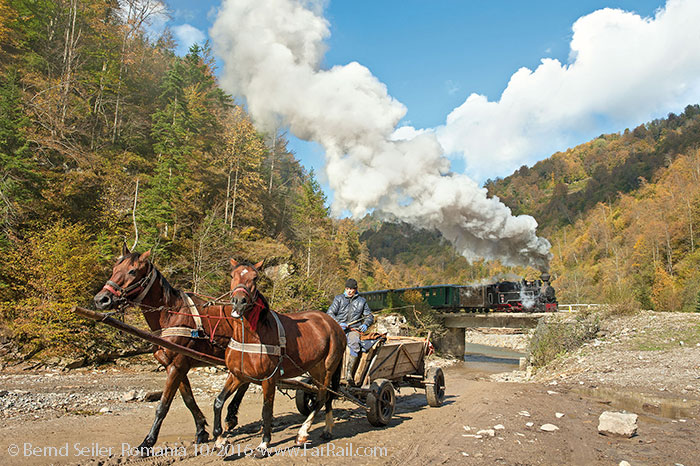

It is there again! The four wheeled,genuine Viseu-tender! This ten years after my first attempt to get one back on track, I finally succeeded, with the help of Georg Hocevar and his workshop in Criscior. After the second big flood in Viseu in the past 20 years, the chassis of this tender was found and rescued from the river bed, twisted, damaged and minus all small parts as well as the complete wooden body. After searching for the remains of this tender for several years without any success, Georg Hocevar found it under a heap of planks in the wide depot area of
Another project which turned out to be much more expensive than planned was to recreate the plank train of Comandau. This train used to run Monday to Friday from Comandau to the incline and after passing over the incline from the valley station, down to Covasna. I wanted to hire the planks for a one train event, but due to the restriction of wood transport in

Global warming has reached
Until the early 1990’s, forestry lines were still common in
The best opportunities for good pictures and videos can be found on the 40-plus km long line of Viseu de Sus. The other lines are less than half as long as this river valley line from Viseu, but still offer a good variety of opportunities and some very interesting situations for pictures.
A feature of this trip will be a night in the mountains. We’ll visit a forestry log cabin and go to where they cut the timber. The logs will be brought to the railway by horses and probably loaded by hand. This is no longer the normal operation but it is how it was done decades ago. So our focus is not only on the line and the steam trains but also we’ll take videos and photographs of logging activities from the forest to the sawmill.

The use of a particular steam locomotive cannot be guaranteed. We can count, however, on the talent and improvisation of the local crews and we hope to be able to use the equipment we want.
We’ll see different types of locomotives in use. In Viseu we’ll use one of the almost “indestructible”
We just can’t say for how long such events like this will be possible in the Romanian forest. We don’t even know whether we can execute all events as planned but we’ll do our best to bring all these ideas to fruition. A landslide, a flood or something like that could easily destroy major parts of a railway in the Carpathian valleys. That’s why absolutely nothing in this tour can be guaranteed. On recent tours it has always been worth taking the chance to be there and we’ve had good results.
In addition to the forestry lines we’ve added the steam operated industrial narrow gauge line of Brad – Criscior and a section of the former state railway operated narrow gauge line of Turda – Abrud. In Brad we’ve chartered an authentic freight train with a Resita locomotive and about five freight cars, just as it used to be some 30 years ago. This few km long line hasn’t seen many changes over the last decades. It’s an industrial line, completely different from the forestry lines. The Abrud line is surrounded by mountains and offers plenty of good opportunities. We’ll probably run an authentic short mixed train here.
The leaves of the trees should be colourful at this time of the year. It depends a bit on how dry or wet, warm or cold the summer was, but in general we expect colourful trees and in the mountains, maybe, the first snow.
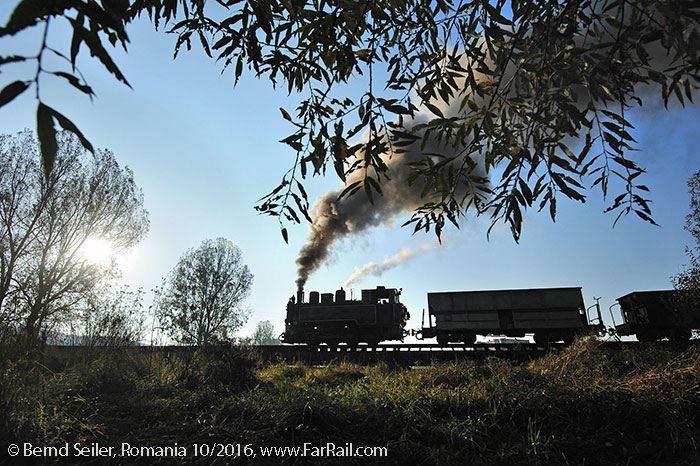
|
Date |
Itinerary |
|
07.10. |
We’ll meet at the airport of Cluj Napoca around 14.00 hrs. We can book the flight for you if required. Bus transfer to |
|
08.10. |
In the morning we’ll steam uphill into the mountains. Today is Sunday, so we don’t need to worry about regular trains and have all the time we need for many photo stops and runpasts. Our train consists of a Resita locomotive (hopefully 764 469, the original loco from Viseu), the one and only authentic tender, a passenger coach and several empty trucks, just as the normal train used to be many years ago. Accommodation in a simple guesthouse in the mountains above Faina. |
|
09.10. |
In the morning we’ll go further up with our train, as far as possible. Above Valea Babei the track condition is doubtful and we might be unable to continue far beyond that. After some more photographs we’ll head for a place where the logs are being cut. We’ll follow the route of the logs from the forest to the railway line where we have planned a loading process by horse and manpower over a loading ramp which was rebuilt by FarRail Tours. The scenery will be just as it used to be two decades ago. In the afternoon and evening we’ll return to |
|
10.10. |
We’ll follow the regular diesel trains with a steam hauled passenger train into the mountains. The passenger train of Viseu used to run every Monday. With four Unio Satu Mare coaches and the original tender, it is now possible to recreate the passenger train as fully authentic. We’ll go to Novicior or Paltin, maybe a bit beyond. Today we need to work around all the scheduled diesel trains and railcars and adjust our running times accordingly. However, some good pictures will be possible as the train stops several times on the way, where we can get off and walk a bit forward and wait for the train at a good position. In the late afternoon we’ll go by charter bus to Moldovita. Accommodation in Moldovita. |
|
11.10. |
In the morning we’ll run a charter train on the rebuilt line of Moldovita alongside the traditional houses to the current terminus. We’re using logging trucks and a van. We’ll use a Resita-type locomotive. Afternoon/evening charter bus transfer over the adventurous serpentines to Comandau. Accommodation in a basic pension on the high plateau of Comandau. |
|
12.10. |
Early in the morning we’ll run a plank train for the last time on the remains of the line up to the incline. After many pictures we’ll roll back to Comandau, off-load one of the plank wagons and go with an empty logging train into the forests. Our train will be hauled by a Budapest-built locomotive. Locomotive, trucks, planks and logs are all brought to here by low loader on the road. At a suitable place we’ll load these empty logging trucks with logs using a traditional “Ifron” front loader forestry machine. The loading process will represent the authentic way they did it (and still do it) when machinery was used. We’ll enjoy a picnic in the forest and wait for the better afternoon light. In the afternoon we’ll return with a loaded logging train to Comandau. Accommodation in a pension in Comandau. |
|
13.10. |
Overnight we’ll have brought the Budapest loco and the trucks down to Covasna by road. Our little train will run a very few miles on the “flat” stretch of the railway. Around 10.30hrs we’ll continue by our charter bus to Brad. Motel in Brad. |
|
14.10. |
In the morning we’ll take a About 11.30hrs we’ll continue to Campeni, where another narrow gauge steam train is waiting for us. Our Budapest locomotive will haul an authentic train. We’ll go though a beautiful valley up to Abrud. In the late afternoon, when the shadows have reached the bottom of the valley we’ll go by charter bus to Cluj Napoca. Hotel in Cluj Napoca. |
|
15.10. |
Return flight home. The flight can be booked by FarRail Tours if needed. |
On this tour we’ll visit a place where logs come from. This requires some walking through the forest or recently deforested areas. At this time it is not possible to say where this will be or how far we need to walk to get to the logging site. Just be prepared for a walk of perhaps up to half a mile. If you don’t want to see the cutting in the forest you can also wait at the railway line where the cut logs will be probably brought by horses.
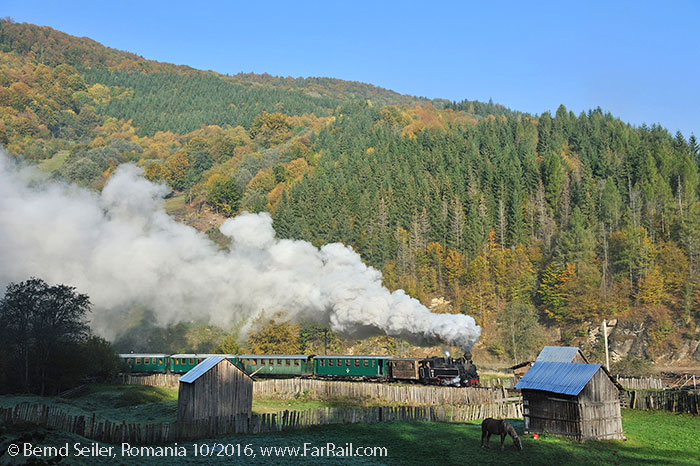

The narrow gauge forest railway of Viseu de Sus is the last remaining one in operation in
The main line starts in
Not only is the landscape something special, the trains in themselves are also noteworthy. We will try to make up authentic trains, as they ran in the eighties, when the line belonged to the state run forestry railway CFF (Caile Ferate Forestiere) and when it was worked by steam locomotives exclusively. In 2014 only two conventional working passenger coaches remained in working order, both painted in a bluish green. Nowadays there are five of these coaches back in service, so we are able to haul an authentic passenger train. Besides locomotive, an original four wheel tender and passenger coach we’ll carry several empty trucks for the logs uphill to the loading points. Sometimes there are forestry tractors or other machinery that will have to be brought up into the forest. This equipment will be carried by the railway as well. We don’t have a direct influence on the train dispatching but our chances of getting an authentic train behind the locomotive are quite good. On our previous trips the train has looked authentic.
At the intermediate stations, during unplanned stops (to raise steam pressure or get one of the log bogies on the track again) and stops for taking on water, we will have the opportunity to take pictures of the train and its surroundings. Lots of shunting activity can be seen as they leave the log bogies at the loading points. In addition we’ve planned some runpasts along the line.

But remember, everything about the tour is unpredictable. Please expect delays, shortages of wagons and couplings for the wagons, derailments, inaccurate or no information and so on. We’ll try to sort all these things out in advance but experience tells us to expect the unexpected. However, things usually work out in a very satisfactory way. So it will be the same as on our previous trips: we’ll need to arrange things on the spot, try to get the wagons we want and find the best opportunities together with the local railway staff, who will be as helpful as they can be.
We’ll try to get a loaded train and bring it down to the sawmill in Viseu de Sus. However, there is a certain resistance to doing this and only if all the necessary people work together will we have the chance to get a loaded train. It depends on the negotiation skills of our partner in Viseu. We have no real influence on the decisions of the railway.Moldovita was a really nice forestry line. In its last years of operation they used a


We’ll make a visit to the depot where our loco will be fired. Along the line we’ll pass several old-style wooden houses. Unfortunately, the parallel road has been paved in recent years. However, there are still plenty of nice pictures possible.
Covasna and Comandau were part of a forestry line, connected by an inclined plane in Siclau. In Comandau several lines headed into the forest. One of them was used up until 16 years ago. But after the sawmill in Comandau was closed, the railway lost its major contractor and was closed as well.
What remains is about four kilometres of the track into the forests from Comandau (Komandó) on the way to the pass at Holomu (Halom). The line ends near the old loading point at Cumpana. In addition, we’ve encouraged (and paid for) them to re-build a part of the line over a bridge near Comandau. On these sections you will find many nice positions for pictures, especially in the chilly morning air. The altitude is about 1000 metres above sea level, so there might be even a little snow in October. Close to the current terminus of the railway we’ve arranged trucks, which will load their logs on to our wagons. During the loading process we’ll enjoy a picnic in the forest and later return with a real logging train to Comandau. Our locomotive will probably be the Budapest-built 0-8-0, 764 243.


Two years ago we bought enough planks to make four full wagon loads. The trains to the inclined plane used to have such loads on, and we can hence recreate another authentic train composition. After our tour I’ll sell these planks, so it will be the last and final chance to see such a train on the forestry line of Comandau.
Overnight we’ll transfer our locomotive by low-loader truck from Comandau to Covasna (Kovaszna). There we’ll use the loco on the remaining bit of the line for a short charter train with logging trucks. As we do not have a van here we’ll travel in a diesel train with fancy tourist coaches ahead of our steam train.
Brad – Criscior is a short industrial line from the state railway station in Brad to an industrial complex for repairing and construction of railway and mining equipment and railway vehicles, in Criscior. The line leaves the state railway on a curve, passes a river bridge and follows a small road in a populated area. In some places, a large industrial pipe runs parallel to the line, as was the situation 30 years ago. The scenery in this part is really ugly – so ugly, that it becomes photogenic again! But in the first section of the line you can make some nice countryside shots, so don’t worry too much. We’ll form a train out of about five coal hoppers and the local

The former state railway operated narrow gauge line from Turda to Abrud is still serviceable in the short but very scenic section from Campeni to Abrud. This part of the line is surrounded by mountains. Especially photogenic are the little, rural villages along the line which haven’t changed much since 1990. A white painted, wooden church is sitting in the valley of the railway – just perfectly placed to include it in the picture. In Autumn, the locals cut the meadows to prepare food for their animals in winter. They still pile this up traditionally, so we may find some hay stacks along the line. Something like this is almost extinct in Western Europe these days. The classic
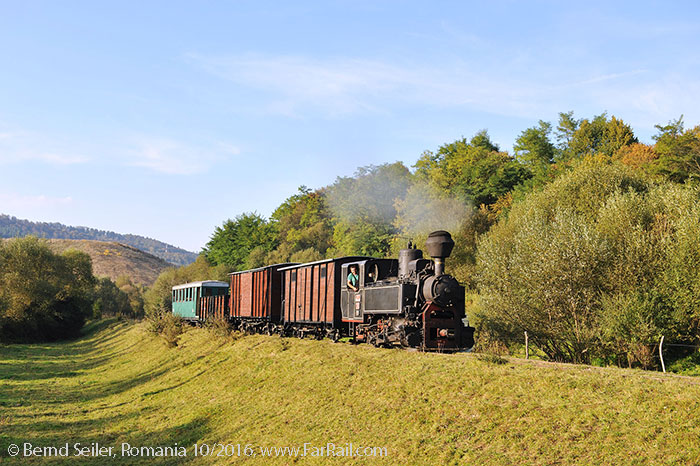

The use of a specific locomotive cannot be promised on any line we’ll visit. In Viseu we will use steam engines for the regular trains depending on their availability. We don’t know which steam locomotives will be operational. The engines built by
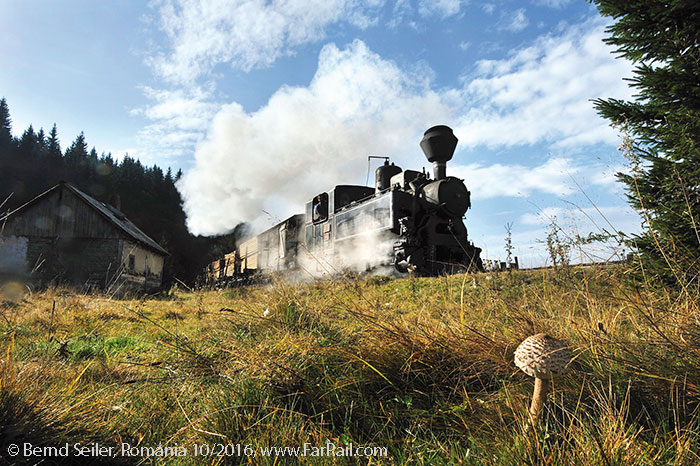
In our pensions and hotels there are sufficient power supplies for battery charging. In our accommodation in the mountains, there is no cell phone signal available (luckily).
Health: no problems exist concerning your health. The water from the numerous springs along the line in Viseu can be drunk without a problem; even the small streams just above the first village have clear and drinkable water. The only serious health risk is if you are not careful around an operating railway. Jumping up or down from moving trains is not allowed. Getting on or off, and travelling on the train is at your own risk, so take care along the railway. Wear good sturdy shoes.
For this tour you will need a valid passport, EU citizens only a valid ID card. A visa for citizens of the European Union is not necessary. For citizens of other countries please contact your local Romanian embassy for details.
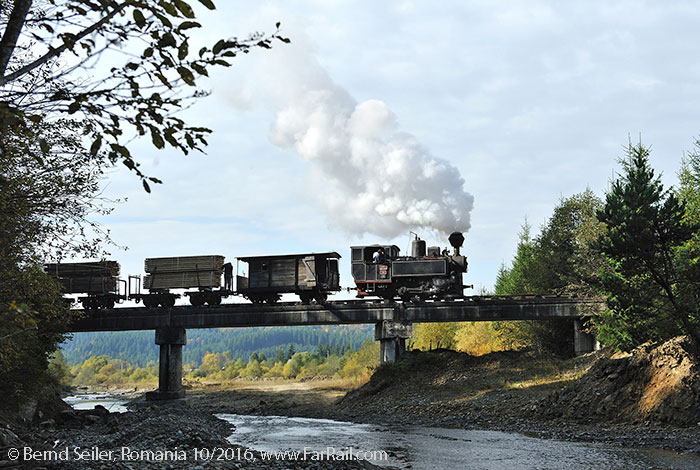
You’ll need little money in local currency. Food, some of which is not included, and beverages are quite cheap. In Viseu we’ll have some beverages on the train, including hot coffee.
The tour is planned with the dedicated photographer and video filmmaker in mind. The itinerary is designed for those who think it more important to get the perfect shot, not necessarily to sample the local food, bars or nightclubs.
Please remember that the accommodation, buses and the forest railway itself do not necessarily conform to current EU-standards. That’s exactly one of the reasons why we are going there. Safety and environmental standards are still not fully developed so a word of warning: Please beware of the dangers in and around the railway and other modes of transportation. An accident and health insurance policy covering foreign countries is absolutely essential. FarRail Tours cannot be held responsible for any accidents, delays etc. You may also consider a trip cancellation insurance.
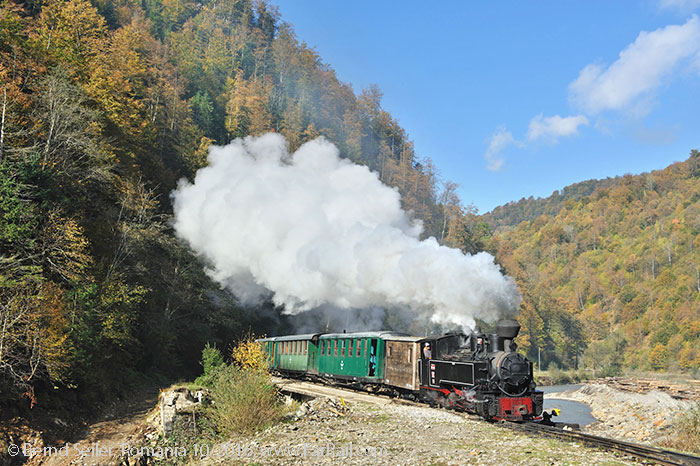
| Romania | ||
| Industrial and Forest Railway Steam in a Golden Autumn | 22 to 28 participants | £1,740 |
| 07.10.2017 – 15.10.2017 | 16 to 21 participants | £2,070 |
| Single room surcharge | £200 | |
| Registration Deadline: 17.08.2017 | ||
For £180 (GBP) you can add a full board package which includes dinner from October 7th up to lunch on October 14th. On October 8th and 9th in Viseu, beverages are included as well.
The price includes:
Not included are: